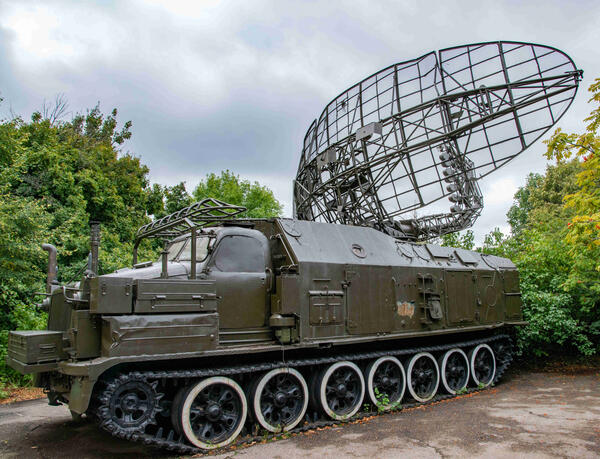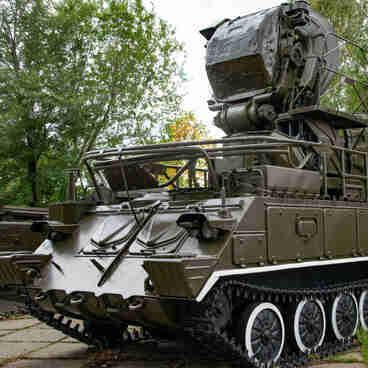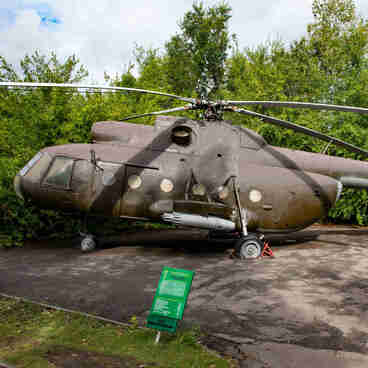The 1S12 target acquisition radar of the 2K11 Krug self-propelled anti-aircraft missile system was developed at the Research Institute No. 208 of the Novosibirsk Plant. The project was led by Vitaly Veniaminovich Reisberg. The station was put into service in 1964.
The 1S12 was designed to detect and identify air targets, select targets based on the features of their movement, determine the coordinates of up to six selected targets and transmit them to the 1S32 missile guidance station using the central radio link station.
The same radar under the designation P-40 “Armor” was also used in radar units of military air defense. The 1S12 station could detect a fighter aircraft within a range of up to 180 km at a flight altitude of 12,000 m and up to 70 km at a flight altitude of 500 m.
The station was capable of a continuous 360-degree radar coverage. During the all-around scanning survey, four beams were formed sequentially in the elevation plane: the two lower ones with a width of 2° and 4°, as well as the two upper ones with a width of 10° and 14°. The beam direction could be controlled electromechanically.
The radar was powered by built-in gas turbine units with a capacity from 40 to 120 hp. The data between the radar and other military installations was transmitted using encrypted radio communication. It made it possible to drastically reduce the time spent on setting up the radar and closing it down.
To determine the real-time coordinates of the station on the move and to ensure that the station arrived at the pre-determined area without using ground landmarks, the AT-IIIM precise topographic positioning device was used. The radar also used the Tantalus-K1 transponder to identify the detected aircraft as friend or enemy.
The radar was mounted on tracked chassis of the AT-T heavy artillery tractor, which was developed in the design bureau of the Kharkiv Locomotive Factory. In terms of some characteristics, including security, it was inferior to the chassis of the SU-100P howitzer.
The choice of chassis was determined by the weight of the 1S12 radar: it was twice as heavy as the missile guidance station. The 1S12 radars were assembled at the Lianozovsky Electromechanical Factory. More than 450 units were manufactured.
The 1S12 was designed to detect and identify air targets, select targets based on the features of their movement, determine the coordinates of up to six selected targets and transmit them to the 1S32 missile guidance station using the central radio link station.
The same radar under the designation P-40 “Armor” was also used in radar units of military air defense. The 1S12 station could detect a fighter aircraft within a range of up to 180 km at a flight altitude of 12,000 m and up to 70 km at a flight altitude of 500 m.
The station was capable of a continuous 360-degree radar coverage. During the all-around scanning survey, four beams were formed sequentially in the elevation plane: the two lower ones with a width of 2° and 4°, as well as the two upper ones with a width of 10° and 14°. The beam direction could be controlled electromechanically.
The radar was powered by built-in gas turbine units with a capacity from 40 to 120 hp. The data between the radar and other military installations was transmitted using encrypted radio communication. It made it possible to drastically reduce the time spent on setting up the radar and closing it down.
To determine the real-time coordinates of the station on the move and to ensure that the station arrived at the pre-determined area without using ground landmarks, the AT-IIIM precise topographic positioning device was used. The radar also used the Tantalus-K1 transponder to identify the detected aircraft as friend or enemy.
The radar was mounted on tracked chassis of the AT-T heavy artillery tractor, which was developed in the design bureau of the Kharkiv Locomotive Factory. In terms of some characteristics, including security, it was inferior to the chassis of the SU-100P howitzer.
The choice of chassis was determined by the weight of the 1S12 radar: it was twice as heavy as the missile guidance station. The 1S12 radars were assembled at the Lianozovsky Electromechanical Factory. More than 450 units were manufactured.




